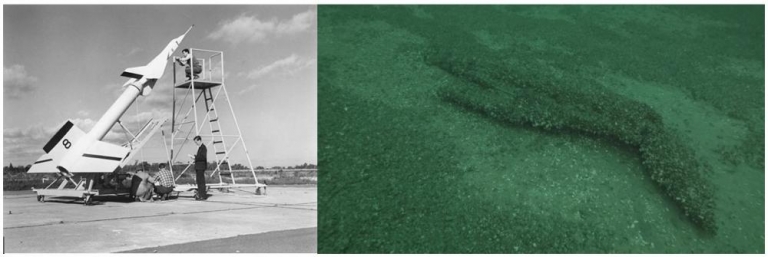
On October 26, 2017, GE Venture company Avitas Systems partnered with Kraken Robotics to develop subsea inspection solutions for the oil and gas industry. This a milestone for Kraken Robotics because for the past two years management has been communicating a search/recovery/inspection, subscription model called Robotics-as-a-Service (RaaS) for sea drones.
We’ll dive into the Kraken/GE/Avitas relationship later because we first want to detail Kraken Robotic’s larger, near-term opportunity selling its sensors and systems – opportunities that may generate tens of millions of dollars in revenue.
Kraken’s Near-Term Opportunities are Bigger than RaaS
In the video below, CFO Greg Reid discusses (at 4:55) a potential Far East Navy contract that could be worth $50 million to Kraken Robotics.
[youtube]https://www.youtube.com/watch?v=MnBC3agzuvk[/youtube]
The Royal Danish Navy wants to replace its old side-scan sonars (SSS) with synthetic aperture sonars, or SAS (Kraken’s specialty). The contract’s value is between 100 – 200 million DKK (C$20-40 million).
This past October, Canada’s Innovation Minister Navdeep Bains announced 9 technology superclusters were shortlisted for $950 million of government funding. An Ocean technology supercluster is amongst the contenders. Pundits believe that the government will ultimately distribute the funds to 3 to 5 superclusters. Kraken could benefit if the government approves the Oceans supercluster.
Kraken announced a $2 million robotics contract on September 21, 2017 for advanced sensors, underwater robotics and software. Delivery of the entire contract is expected in 4Q 2017.
On September 7, 2017, Kraken also announced a contract worth about $3 million to supply sensors and processing solutions to Ocean Infinity, a seabed mapping and intelligence firm. Interestingly, last month, the Malaysian government announced that it had selected Ocean Infinity to begin a new search for Malaysian Airlines flight MH370.
Industry Heavyweight Comes Aboard
What do you call a Vice Admiral of the U.S. Navy who served as the Commander of the U.S. Navy Submarine Forces, and who was the founder and CEO of ThayerMahan, a maritime security firm, and is recognized globally as one of the foremost authorities in undersea operations? Kraken Robotics calls him a Board member and plans to leverage Mike Connor‘s knowledge, expertise, and relationships to win new business.
Give Your PA a Kick in the RaaS
Although RaaS is a longer-term opportunity for Kraken, the Company has already executed on the model. Regarding the GE Ventures partnership, Kraken’s CEO Karl Kenny stated that he looked forward to announcing the first contract with Avitas Systems during Q4, 2017. We obviously can’t confirm or deny this, but we can say that Avitas Systems has developed several business cases using Kraken’s technology.
In this article, Brad Tomer, Avitas Systems’ VP of Operations, describes Kraken’s SeaVision sensor as offering ” unprecedented colorized laser imagery.” Not a bad endorsement from one of the world’s largest industrial companies.
GE has been vocal about RaaS opportunities. This past May, Mr. Tomer, who is from the oil & gas vertical, detailed GE’s service and RaaS plans. In the video below, he states that GE:
- Is looking at inspection-as-a-service across all GE horizontals;
- Wants to be autonomous from end-to-end;
- Energy industry inspections are dull, dangerous, and dirty (better suited for drones);
- Remotely operated underwater vehicle contractors are expensive (renting ships alone cost $200-$300k/day),and the work is slow;
- Robots instead of humans are better suited to confined spaces like tanks, and;
- Working on developing a low-cost platform with a company (likely referring to Kraken Robotics).
[youtube]https://www.youtube.com/watch?v=8J6dA8hI2-g&feature=youtu.be&t=43m45s[/youtube]
The GE/Avistas Systems announcement builds upon the RaaS contract Kraken executed for OEX Recovery Group to find Avro Arrow models, a highly public project that the media (including the BBC) pounced upon.

Left: Avro Arrow model about to launch in the 1950s. Right: Avro Arrow model at the bottom of Lake Ontario in 2017
Media Latching onto Sea Drones, Sensors, and RaaS
As mentioned before, now it seems that the media, industry experts, and tech bloggers are behind underwater robotics and RaaS. Here is a sampling of what these folks have written, along with what we believe are the key takeaways:
Sea Drones and Sensors:
September 27, 2017: SUBSEA World News – “Today we are transitioning our UUV (unmanned underwater vehicle) Detachment into the first UUV Squadron. Why is this historical? It’s because in standing up UUVRON 1, it shows our Navy’s commitment to the future of unmanned systems and undersea combat.” – U.S. Navy Captain Robert Gaucher
September 21, 2017: U.S. Naval Institute News – … the Navy and Marine Corps have been testing as many unmanned vehicle prototypes as they can, hoping to see the art of the possible for unmanned systems taking on new mission sets. Many of these systems being tested are small surface and underwater vehicles that can be tested by the dozens at tech demonstrations or by operating units.
September 18, 2017: Bloomberg – At the moment, underwater robots represent a bigger chunk of the market than boats. Sales are expected to hit $4.6 billion in 2020, more than double the amount from 2015, according to ABI Research.
September 15, 2017: The Washington Post – Lockheed and Boeing argue the robotic subs could one day become the Navy’s robotic scouts, augmenting the efforts of the Navy’s limited and aging fleet of manned submarines.
RaaS:
Kraken’s Story is Working
Chat soon.
Sean

